Danube-Auen National Park
Donau-Auen National Park (German: Nationalpark Donau-Auen) covers 93 square kilometres in Vienna and Lower Austria and is one of the largest remaining floodplains of the Danube in Middle Europe.
| Donau-Auen National Park | |
|---|---|
IUCN category II (national park) | |
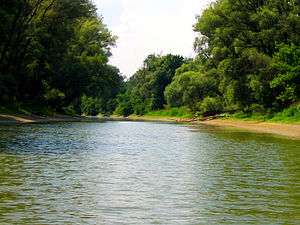 Donau-Auen near Hainburg | |
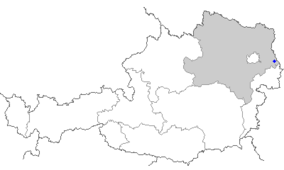 | |
| Location | Vienna and Lower Austria |
| Nearest city | Vienna |
| Coordinates | 48°8′N 16°55′E |
| Area | 93 km2 (36 sq mi) |
| Established | October 27, 1996 |
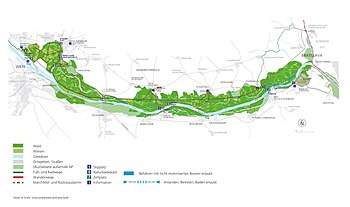
The German word Aue (variant Au) means "river island, wetland, floodplain, riparian woodland", i.e. a cultivated landscape in a riparian zone. The words Aue and Au occur in a large number of German place names—including Donau, the German word for the Danube River—and refer to forests, meadows, and wetlands in river and stream lowlands and floodplains. The Danube-Auen National Park protects a large area of lowland forests, meadows, wetlands, and other riparian habitat along the Danube just downstream of Vienna.
The Park was designated an IUCN category II national park and spans the areas of Vienna (Lobau), Groß-Enzersdorf, Orth an der Donau, Eckartsau, Engelhartstetten, Hainburg, Bad Deutsch-Altenburg, Petronell-Carnuntum, Regelsbrunn, Haslau-Maria Ellend, Fischamend and Schwechat.
Creation of the National Park
Until the 19th century the Danube was an untamed river. In the 19th century, extensive engineering began to alter the natural balance of the river landscape dramatically. Many side-channels were dammed so that they now carry water from the Danube only at flood stages. Ever more intrusive engineering interventions were accompanied by decades of heavy forestry use in many parts of lowland forests. In the 1950s, development began of a nearly unbroken chain of hydroelectric power plants and associated dams on the Austrian section of the Danube River.
In 1984, the planned construction of the Hainburg hydroelectric power plant, just downstream from Vienna, threatened the destruction one of two remaining free-flowing sections of the Danube in Austria and its riparian forests (the other remaining free-flowing section in Austria is upstream, near Wachau). An outcry by environmental and nature protection groups caused nationwide protests against the project. The operator of the power plant project disregarded the protests and began work to clear the area. Protests stepped up, eventually leading to the occupation of the Hainburg wetlands by thousands of people from all ages and professions (the so-called "Hainburg Movement"). After police tried several times to clear protestors from the area, in December 1984 the Federal Government declared a pause for reflection. In January 1985 the Austrian Supreme Court forbad further deforestation. In March 1985, the so-called Konrad Lorenz-Volksbegehren (petition), signed by 353,906 people, demanded the prohibition of large power plants such as Hainburg and the establishment of a national park in the area of Hainburg. On 1 July 1986, the Administrative Court released a decision cancelling the water rights of the planned power plant.
Extensive scientific studies were then made of the area, with surprising discoveries. More species of fish were observed than was known at the time the planning of the power plant.
The most important result of these studies was that the Danube lowlands area (Donau-Auen) in and east of Vienna was determined to be worthy of becoming a national park. It was also determined that creating a power plant in the area would not be compatible with national park status for the region. On October 27, 1996, a State Treaty between the Republic of Austria and the federal states of Vienna and Lower Austria was signed. With that treaty, Donau-Auen National Park was officially opened.
Flora and fauna
In the National Park area there are more than 700 species of higher plants, more than 30 mammals, 100 species of breeding birds, 8 reptiles, 13 amphibian species, and around 50 species of fish. Among the most characteristic inhabitants of the wetlands of the National Park are the Danube crested newt, European pond turtle, European mudminnow, white-tailed eagle, Eurasian kingfisher, and Eurasian beaver.
With the variety of insects living on both land and water, and other invertebrates, the total number of species in Donau-Auen National Park is estimated to be at least 5,000.
The River
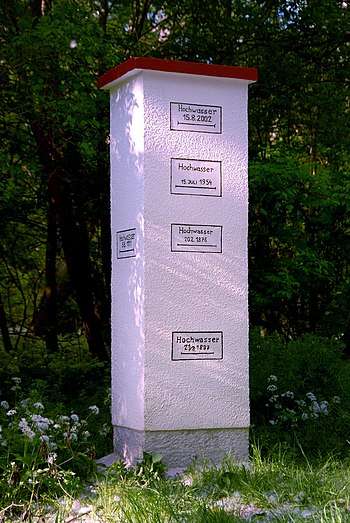
The main channel of the Danube was separated from its side channels by the flood control measures that were constructed around the year 1900. The outcome was a higher current velocity in the main channel, with a resulting deepening of the river bed, while in the side channels--which no longer had current flowing through them--sand and loam deposits were no longer removed by the current. In a natural riparian ecosystem woody plants and deadwood have a strong impact on the natural flow dynamics, by stabilizing riverbanks, by reducing erosion, and by creating areas of reducing or increased flow rates, and thus affecting in which areas sediments are deposited or removed. Large tree trunks and accumulations of smaller flotsam cause the water to stagnate and the speed of the current to drop, leading to increased sedimentation.
To counteract the effects of the flood control measures, beginning in 2002 individual side channels were tied in with the main channel again--at least at high water times--via Gewässervernetzungen ("water crossings"), which lower or remove the levees protecting those channels.
In a 2006 pilot project created with the support of the LIFE+ Program of the European Union and the Austrian riverways agency via donau, about three kilometers of the complete flood works were removed across the river from Hainburg, so that the river once again could spread into the floodplain areas. In a similar project near Witzelsdorf, about one kilometer of the levees were removed. After the completion of the pilot projects in Hainburg and Witzelsdorf, future plans for this river engineering project are for removal of 50% of the levees and flood control works between Vienna and the eastern border of Austria.
Aside from a revitalization of the Au (riparian zone), the project promises to mediate the effects of floods on the river and to stabilize the riverbed to the benefit of both river ecology and navigation.[1]
Photo gallery
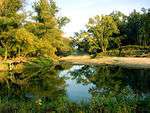 An old channel of the Donau-Auen near Schönau
An old channel of the Donau-Auen near Schönau Spring flood waters between Schönau and Orth an der Donau
Spring flood waters between Schönau and Orth an der Donau Levee, field, and woodland in the Donau-Auen
Levee, field, and woodland in the Donau-Auen Beaver lodge
Beaver lodge
 The Wild-Weinrebe (wild grapevine) appears very seldom in the Austrian Donauauen and is extremely endangered.[2]
The Wild-Weinrebe (wild grapevine) appears very seldom in the Austrian Donauauen and is extremely endangered.[2] The Broad-leafed Solomon's seal is a typical variety in the Harten Au.[2]
The Broad-leafed Solomon's seal is a typical variety in the Harten Au.[2]
 A stand of endangered military orchid.[2]
A stand of endangered military orchid.[2]_sl12.jpg) The flowers of the very endangered early spider-orchid imitate the female sand bee, and so entice the male bees to land and thus pollinate the plants[2]
The flowers of the very endangered early spider-orchid imitate the female sand bee, and so entice the male bees to land and thus pollinate the plants[2] The Swiss spikemoss (Schweiz-Moosfarn) is a nondescript spikemoss and is endangered in the Austrian portions of the Pannonian geobotanical region in Central Europe.[2]
The Swiss spikemoss (Schweiz-Moosfarn) is a nondescript spikemoss and is endangered in the Austrian portions of the Pannonian geobotanical region in Central Europe.[2]
- Andrea Katschthaler: (Titel), Der Standard, Print, 28. August 2007, S. 9. – Onlineversion: Die Donau bekommt wieder mehr Platz derstandard.at, 29. August 2007, abgerufen 21. Oktober 2016.
- Manfred A. Fischer, Karl Oswald, Wolfgang Adler: Exkursionsflora für Österreich, Liechtenstein und Südtirol. 3., verbesserte Auflage. Land Oberösterreich, Biologiezentrum der Oberösterreichischen Landesmuseen, Linz 2008, ISBN 978-3-85474-187-9.
External links
| Wikimedia Commons has media related to Nationalpark Donau-Auen. |
- www.donauauen.at (in English and German)
- Wikipedia commons photo gallery
- Infothek - Dateien und Medien rund um den Nationalpark Donau-Auen zum Download
- Juniorranger - Website für Jugendliche, die im Nationalpark mithelfen wollen
- Camps - Website über das Camp-Angebot der Nationalpark Donau-Auen für Kinder, Familien, Vereine und Schulklassen
- Blog - Aktuelles rund um den Nationalpark Donau-Auen
- Donau-Auen (Lobau) - Erholungsgebiet in Wien (Webservice der Stadt Wien)
- Life Natur Projekte in Nationalpark Donau Auen (Life Nature Projects in Donau Auen National Park, in German)